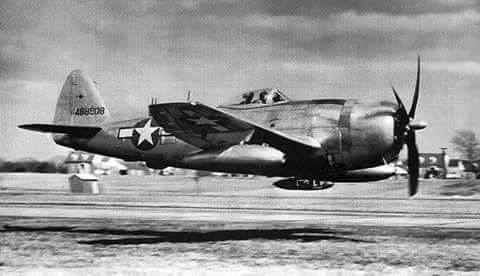Re: Að gera lágt
Póstað: 18. Feb. 2015 13:34:51

This picture reminds me of a story about my dad, Phil Savides, that appeared in a 2003 Flight Journal issue. My dad was a P-47 pilot with the 50th FG's 313th FS. Here is an excerpt of the story: ....
"As I flew in this harrowing manner, I saw in the rearview mirror that my propeller was kicking up a continuous wake of dust and dirt! All of a sudden-dead ahead and seen through the whirling circle of my propeller-a German soldier was running toward me! Maybe he was trying to find a ditch or a bomb shelter to protect himself. My fighter was hugging the ground and moving at blinding speed, and my first thought was that he had better hurry because of our rapid closure! You have to understand that there was no thought in my mind to squeeze the trigger and certainly no urge to run him down. But my right hand (as if it had a mind of its own) resolutely grasped the stick and, with minute movements, held the Thunderbolt down low; it was all but scraping the soil. For me to have turned aside would have required a bank that surely would have caught a wingtip-with fatal results for me!
"There is no doubt that a quick tug on the stick would have made my aircraft hop over him, but that maneuver would have put me at an altitude that would have drawn horrendous fire at point-blank range. We had stirred up a hornet's nest with our attack on the neighboring rail yards, and I would have had every weapon within a mile drawing a bead on my plane. As my fighter swept toward the running soldier, I prayed that he would throw himself onto the ground, but he did not. Instead, incredibly, he stopped upright in his tracks-clearly paralyzed with fear!
"I saw his face, his mouth agape, looming toward me. I saw the buttons on his coat and finally, I saw his helmeted head disappear close under the engine cowl. But there was no sickening thud and no abrupt deceleration. There was only the steady hum of the engine driving the 13-foot, 4-blade propellers that were knifing my P-47 through the air. How was it possible that with two foes so resolved to occupy the same space, there was no grotesque flutter of severed limbs, no gory splattering of blood and no sudden vibration of the engine that would have signaled the loss of a prop blade?
"Completely puzzled by the absence of a collision, I kept my distance just a few feet from the ground until I had traveled about a mile. I pulled back on the stick and went to full throttle, shooting skyward toward the rest of my squadron........"
Many years later, Lt. Savides managed to do some math on this incident. He figured that his rpm were 2250, and multiplying this by 60 minutes, the results netted 135,000 revolutions per hour. Multiply this by the four blades, and there are 540,000 slashing propeller blades per hour. Taking this a step further, Lt. Savides states that when flying at 250mph, the aircraft moves at 1,320,000 feet per hour. Dividing that by the 540,000 blade rotations reveals that the aircraft and propeller blades move forward 2.44 feet each time a blade moves past the six o'clock position of the propeller's arc.
To better illustrate this, imagine a plane flying with the propeller tips lightly striking the tarmac. The nicks in the runway would be 2.44 feet apart. The German, standing upright and facing his fate, escaped sudden death because, willy-nilly, he chose to stand on precisely the correct spot. A foot nearer would have been fatal! The first propeller blade swept about an inch from his nose, and as the aircraft advanced 2.44 feet, the second one moved through its arc, all but brushing the soldier's buttocks. Lt. Savides said, "I have always wondered whether, after he had coughed my Thunderbolt's gas exhaust out of his lungs, he shouted a curse at me, or maybe he was not a vindictive soul and muttered a prayer of thanks for his good fortune!"